Content
- Characteristic features of the disease
- Causes
- Classification
- Clinical picture
- Drug treatment
- Treatment with folk remedies
- Physiotherapy procedures
- Massage and gymnastics
- Food
- Operation
- Knee arthritis video
Knee arthritis is a disease inflammatory nature. Pathological processes affect the joint and adjacent tissues. A specialist rheumatologist, arthrologist or therapist deals with diagnostics and treatment. The disease is accompanied by characteristic clinical symptoms, with which it is important to immediately go to the hospital. Timely and correctly selected therapy will help prevent serious complications.
Characteristic features of the disease
Knee arthritis provokes inflammation. The disease is acute or chronic. Many people live with knee pain for years and are unaware that a serious illness is the cause. Without timely diagnosis and therapy, the inflammatory process gradually progresses, the affected tissues are destroyed. Degenerative changes lead to the fact that the patient becomes disabled. There is a complete loss of function of the affected joint.
Causes
Knee arthritis is accompanied by a strong inflammatory process.
There are numerous provoking factors against which disorders develop:
- damage to the lower limb;
- age-related changes, wear of cartilage tissue;
- autoimmune diseases;
- infectious damage to the body;
- accumulation of salts in the joint due to impaired mineral metabolism;
- hereditary predisposition;
- endocrine diseases;
- frequent stress, emotional outbursts.
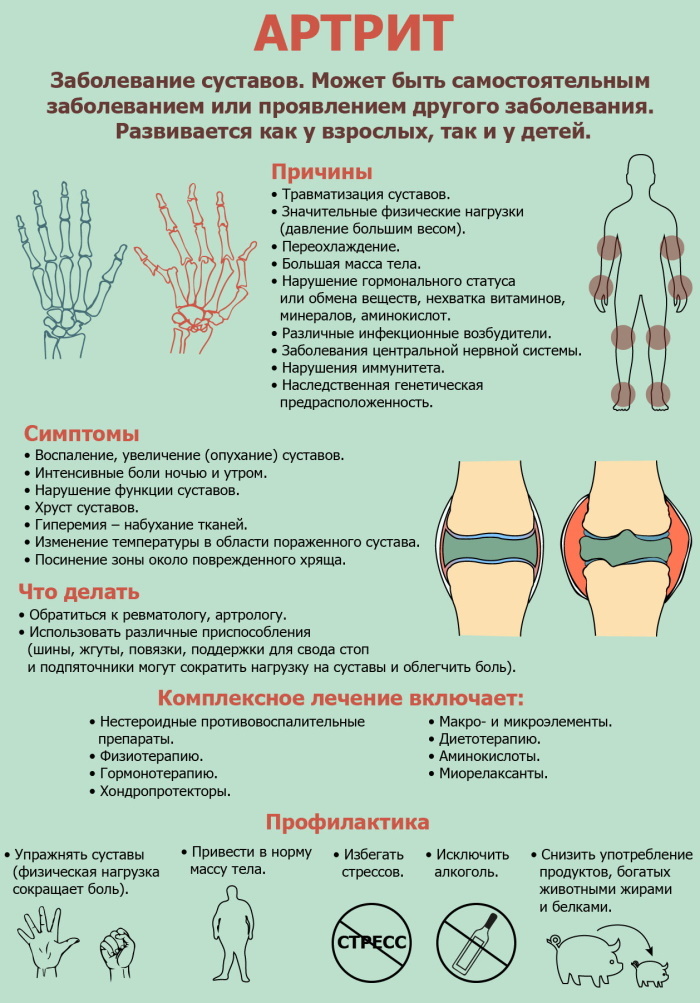
Knee arthritis. Treatment
There are also provocative situations that trigger a pathological mechanism. We are talking about surgery on the legs, a sedentary lifestyle. The same applies to excess weight, great physical exertion, immunodeficiency states.
Classification
Arthritis of the knee (treatment of the inflammatory process is carried out by complex methods under the supervision of a doctor rheumatologist or arthrologist) develops against the background of numerous provoking factors and proceeds with certain symptoms.
Based on these circumstances, in medicine, the disease is classified as follows:
| Name | Description |
| Deforming arthritis | The inflammatory process is accompanied by degenerative changes in the knee joint area. It often develops against the background of arthrosis. |
| Post-traumatic arthritis | Pathological processes develop after injury to the lower limb. |
| Reactive | The disease occurs against the background of an infection of the joint, when pathogenic bacteria have spread through the human body through the blood, lymph. |
| Rheumatoid | Arthritis develops in the presence of infection, and the patient also has autoimmune disorders. |
| Infectious arthritis | Inflammation occurs as a result of an infection of the surrounding tissues in the knee joint area. |
| Gouty | Inflammation provokes impaired uric acid metabolism and salt deposits in the knee joint. |
| Senile arthritis | The disease develops as a result of aging of the body. |
| Juvenile | A pathological condition that is more often diagnosed in children or adolescents. The main reason is hereditary predisposition. |
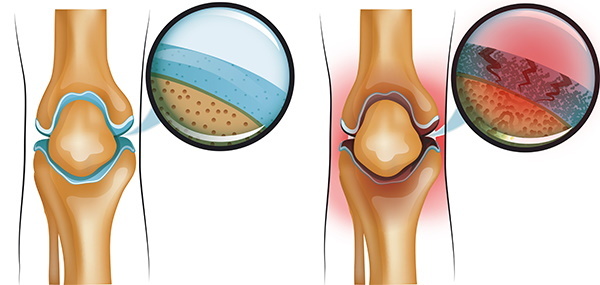 Each type of arthritis of the knee joint is accompanied by characteristic symptoms. A physician or rheumatologist will help to establish an accurate diagnosis. It is important not to delay the visit to a specialist, since progressive inflammation can provoke serious consequences.
Each type of arthritis of the knee joint is accompanied by characteristic symptoms. A physician or rheumatologist will help to establish an accurate diagnosis. It is important not to delay the visit to a specialist, since progressive inflammation can provoke serious consequences.
Clinical picture
Symptoms that accompany arthritis of the knee joint will allow the rheumatologist to determine the degree of development of the inflammatory process and how much tissue is affected in this area.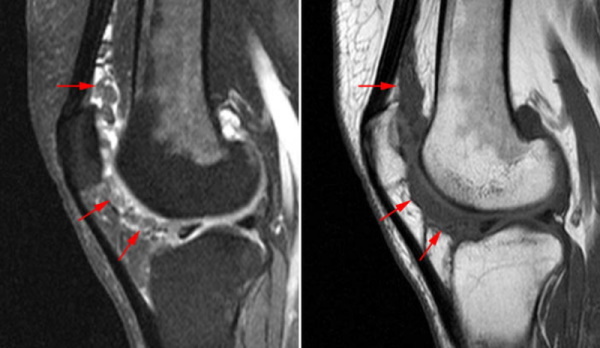
| Name | Symptoms |
| 1st degree |
|
| 2nd degree |
|
| Grade 3 |
|
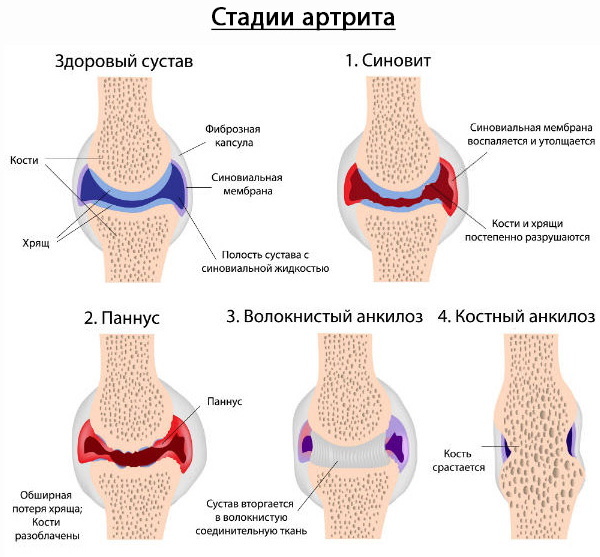
Painful sensations intensify after any physical activity. The local temperature also rises, the skin not only turns red, but also becomes hot.
Drug treatment
Arthritis of the knee is treated with complex methods after a medical examination based on the results obtained. Patients need to strictly adhere to the prescription of a rheumatologist to reduce the likelihood of side effects or complications.
Drug therapy involves the use of the following drugs:
| Drug group | Name | Application |
| Anti-inflammatory drugs | Diclofenac, Meloxicam | Medicines reduce inflammation, swelling, and pain. The drug is injected deeply intramuscularly. The standard dosage for an adult is 75 mg once a day. In difficult situations, it is allowed to administer the medicine 2 times a day. The maximum injection therapy lasts 2 days. |
| Antihistamines | Erius, Claritin | The tablets should be swallowed whole, not chewed and washed down with water. Adult patients are prescribed 5 mg 1 time per day, regardless of food intake. |
| Antibacterial drugs | Erythromycin, Ceftriaxone | Medicines are prescribed to patients in case of detection of purulent arthritis. The tablets should be taken 1 hour before meals. The standard adult dosage is 200-400 mg 4 times a day or every 6 hours. The course of treatment depends on the condition of the person and lasts more often 7-14 days. |
| Chondroprotectors | Don, Structum | Medicines are prescribed to restore cartilage tissue. The tablets are preferably taken with meals, swallowed whole and washed down with plenty of water. Adult patients are prescribed 750 mg 2 times a day. The course of treatment lasts 4-6 weeks. After a break of 2 months, therapy can be repeated.
|
| Antirheumatic drugs | Sulfasalazine, Methotrexate | The drugs suppress autoimmune processes. The medicine is taken orally after meals. The maximum therapeutic dose for an adult patient is 1.5-3 g per day. The medicine should be taken according to a certain scheme, which the doctor selects individually for each patient. The standard treatment lasts 6 months. |
| Glucocorticosteroids | Dexamethasone, Diprospan | The daily dosage for an adult patient is 10-15 mg. It should be divided into 3-4 doses. |
| Hyaluronic acid preparations | Ostenil, Synvisk | Medicines are injected directly into the synovial cavity. Injections are given once a week. The course of treatment includes 3-5 injections. |
Severe pain that does not help stop drugs is eliminated by intra-articular injections (Lidocaine, Novocaine).
Treatment with folk remedies
Knee arthritis (treatment of pathology is selected individually for each patient after medical diagnosis) allows the use of non-traditional methods of healers and healers, but strictly after consultation with a specialized doctor and under his observation.
Healing components are safe for the human body, but there is always the likelihood of allergies or individual sensitivity. Folk remedies will not help completely get rid of arthritis of the knee joint, but in combination therapy they will reduce inflammation, pain and swelling.
Effective recipes:
| Name | Recipe | Application |
| Compress | 1. Young horseradish root (1 pc.) Is peeled. The core is crushed and poured with hot water (1 tbsp.). 2. Leave for 20-30 minutes, filter and squeeze the raw material well. 3. Add thick sour cream or natural honey to the mass (2-3 tbsp. l). 4. All components are well mixed. |
The resulting mass is used for a compress. Spread on a painful area of the body. From above, the mass is covered with a plastic bag and warm material to enhance the healing effect. The compress is done before bedtime and left overnight. |
| Ointment | 1. Mix dry herbs (sweet clover, dandelion and St. John's wort) in equal proportions. 2. Pour all components with hot water (100 ml) and leave for 2 hours. 3. Then strain the ingredients well, squeeze and add 30 g of lanolin, 1 tbsp each. l. natural honey and cosmetic almond oil. The last ingredient will be medical petroleum jelly. It will need 100 g. 4. Mix all components well until a homogeneous mass is obtained. |
The ointment should be stored in the refrigerator for 2-3 weeks. Lubricate the painful area 2-3 times a day. |
| Rubbing | 1. Put 10 g of propolis in a glass container (200 ml), pre-grind. 2. Fill it with pure alcohol. 3. Leave the resulting mixture in a dark place for 2 weeks, shake occasionally 1-2 times a day. |
Before use, it is recommended to dilute the rubbing with warm water in equal proportions. Treatment procedures are carried out 1-2 times a day. |
| Tincture inside | 1. Mix in a glass jar for 2 tbsp. l. dandelion, St. John's wort, chamomile, elecampane, wild rosemary and bearberry. Add 5 berries each of rose hips, hawthorn, juniper, cranberry and barberry. 2. Mix all components well and pour vodka (1 l). 3. The resulting mass should be infused for 2 months in a dark and warm place. Shake the glass container periodically. |
The finished tincture should be taken orally. The adult dosage is 5 drops 2 times a day, mainly after meals. The medicine can be taken with water or diluted in 100 ml of liquid. |
If patients do not have serious diseases of the cardiovascular system, with arthritis of the knee, they can take warm baths with the addition of sea salt or medicinal herbs. It is good to carry out water procedures before going to bed for 1-2 hours, as they relieve fatigue in the legs, eliminate pain syndrome and contribute to the complete relaxation of the human body.
Physiotherapy procedures
Arthritis of the knee (treatment of the inflammatory process is carried out according to the results of a medical examination) requires complex therapy, therefore, during the period of remission, the rheumatologist recommends that patients visit physiotherapy procedures:
| Name | Description |
| Laser therapy | Directed beams activate chemical and physical processes in the development of a pathological focus. Thanks to laser therapy, metabolic processes are activated, the functioning of the immune system improves, and blood circulation is accelerated. Reduces swelling, pain and inflammation. |
| Amplipulse therapy | Treatment is carried out using alternating sinusoidal current, which has a positive effect on the state of the neuromuscular tissues. The functioning of the circulatory system is activated, the neurostimulation of cells is enhanced. Improves the nutrition of muscle and cartilage tissues, thereby slowing down degenerative changes in the joint. |
| Magnetic therapy | During the treatment, a magnetic field is used, which improves metabolic processes in the human body. Decreases inflammation, pain syndrome, tissue edema. The process of regeneration of damaged cells is accelerated. Thanks to the increased blood circulation, the mobility of the knee joint is improved. The magnetic field suppresses the reproduction of pathogenic flora and promotes the elimination of toxins from the human body. |
| UHF therapy | During each session, a high-frequency electromagnetic field with a certain frequency of electromagnetic oscillations affects the human body. UHF therapy helps to reduce soft tissue edema, reduce the intensity of pain and inflammation. |
Physiotherapy is also performed using ultrasound therapy. Special medications with hydrocortisone are selected. Due to ultrasonic waves, the active components penetrate directly into the focus of the inflammatory process.
Massage and gymnastics
Puncturing and specific exercises for knee arthritis can help reduce symptoms. They are prescribed in complex therapy by a rheumatologist or arthrologist, taking into account the individual characteristics of the human body.
Massage procedures reduce knee stiffness, inflammation and pain. Eliminate muscle tension, restore knee mobility. After each session, toxins are removed from the human body, this is facilitated by improved blood circulation. Therefore, even the general well-being of the patient improves.
Therapeutic gymnastics also accelerates blood circulation, promotes the removal of fluid from the cavity of the knee joint and surrounding tissues, against which edema forms. The swelling decreases and the local temperature decreases, the redness of the skin passes. Systemic exercises will help to restore the functioning of the joint and the mobility of the affected limb over time, as well as improve the tone of muscle tissues.
Food
Arthritis of the knee (it is important to treat the affected joint under the supervision of a specialist in order to prevent serious complications) requires the appointment of complex therapy and one of the important areas is a correctly compiled diet. A balanced and varied menu will help slow down degenerative changes in the knee joint area, improve material metabolism and strengthen ligaments and muscles.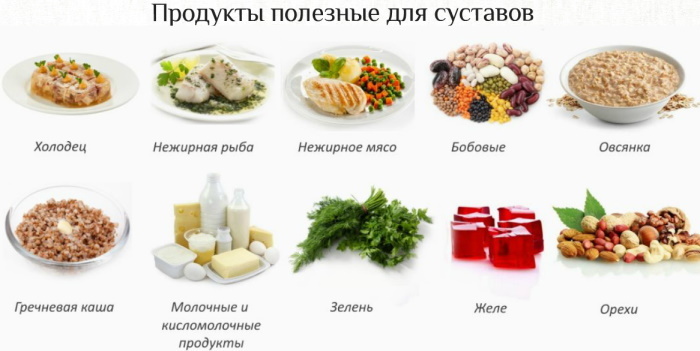
| Featured Products | Prohibited foods |
|
|
A properly formulated diet will improve the blood supply to damaged tissues, restore the process of synovial fluid production. The elasticity of the ligaments and tendons will also increase.
Operation
In the later stages of the development of arthritis of the knee joint or in the event of complications, surgery is indicated for patients. Surgical treatment is performed when degenerative changes in the leg interfere with a person's normal life. In most cases, arthroplasty is indicated. We are talking about the most effective method of surgical intervention, which allows you to permanently eliminate pain and restore leg mobility.
The rehabilitation period after surgery takes 3-4 months, when the patient can fully return to normal life. But after replacing the native knee joint, patients will have to adhere to certain recommendations.
In the chronic form of the disease or rheumatoid arthritis after surgery, patients continue to take medications and undergo tests. Doing so will help stop the progression of the disease and protect other large joints in the body.
Knee arthritis is not a dangerous disease if a person goes to the hospital in a timely manner, has been diagnosed and started treatment. In the later stages, serious degenerative changes develop that cannot be eliminated. Therapy will only help slow down their progression. Therefore, it is important to monitor your health and immediately go to the hospital when the first signs appear.
Knee arthritis video
What is arthritis of the joints:



